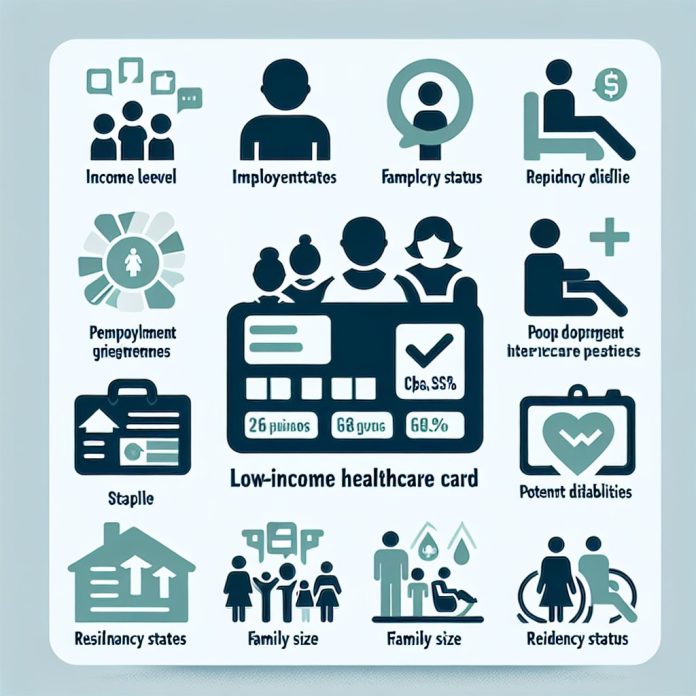
🌟 Introduction
Access to affordable healthcare is a fundamental need for everyone, but it can be particularly challenging for low-income individuals and families. The Low Income Health Care Card (LIHCC) is a vital resource designed to ease this burden by providing eligible individuals with access to reduced-cost medical and pharmaceutical services. This comprehensive guide will explore the eligibility criteria, benefits, application process, and additional resources related to the Low Income Health Care Card.
🏥 What is the Low Income Health Care Card?
The Low Income Health Care Card is a government-issued card that offers a range of benefits to individuals and families with limited income. It is primarily aimed at helping those who are not eligible for other forms of social security payments but still require assistance in managing their healthcare costs.
1. Overview of the Card
- Purpose: To assist low-income earners in accessing affordable healthcare services.
- Benefits: Reduced-cost prescription medicines, doctor visits, and other healthcare services.
🌟 Eligibility Criteria for the Low Income Health Care Card
Understanding the eligibility criteria is crucial for those seeking to apply for the Low Income Health Care Card. The criteria are primarily based on income and residency status.
1. Income Limits
- Income Thresholds: Applicants must meet specific income limits to qualify. These limits vary depending on whether you are single, partnered, or have dependents.
- Income Assessment Period: Income is assessed over an eight-week period prior to the application.
2. Residency Requirements
- Australian Residency: Applicants must be permanent residents or Australian citizens.
- Temporary Visa Holders: Certain visa holders may also be eligible under specific conditions.
3. Age Requirements
- Minimum Age: There is no minimum age requirement, making the card accessible to all low-income earners who meet the other criteria.
🌐 How to Apply for the Low Income Health Care Card
The application process for the Low Income Health Care Card is straightforward, but it requires attention to detail to ensure all required information is accurately provided.
1. Preparing Your Application
- Documentation: Gather necessary documents such as proof of income, residency, and identity.
- Online Application: Applications can be submitted online through the government’s service portal.
2. Step-by-Step Application Process
- Creating an Account: If you don’t already have one, create an account on the government’s service portal.
- Filling Out the Form: Complete the application form with accurate and up-to-date information.
- Submitting Documents: Upload the required documents to support your application.
3. After Submitting Your Application
- Processing Time: Applications typically take a few weeks to process.
- Notification: You will be notified of the outcome via email or post.
📘 Benefits of the Low Income Health Care Card
The Low Income Health Care Card offers a range of benefits designed to help low-income individuals manage their healthcare costs more effectively.
1. Medical Benefits
- Doctor Visits: Reduced costs for consultations with general practitioners and specialists.
- Bulk Billing: Many healthcare providers offer bulk billing services for cardholders, eliminating out-of-pocket expenses.
2. Pharmaceutical Benefits
- Prescription Medicines: Significant discounts on prescription medicines listed under the Pharmaceutical Benefits Scheme (PBS).
- Safety Net Threshold: Once you reach the safety net threshold, your medicines may become even cheaper or free.
3. Additional Services
- Diagnostic Tests: Reduced costs for diagnostic tests such as blood tests and X-rays.
- Hospital Expenses: Assistance with hospital expenses for public patients in public hospitals.
🌍 Impact on the Community
The Low Income Health Care Card plays a vital role in supporting the health and well-being of low-income individuals and families, contributing to overall community health.
1. Reducing Financial Burden
- Cost Savings: Helps individuals save money on essential healthcare services and medications.
- Preventive Care: Encourages regular medical check-ups and preventive care, reducing long-term health complications.
2. Improving Health Outcomes
- Access to Care: Improves access to necessary medical services, leading to better health outcomes.
- Chronic Disease Management: Supports the management of chronic diseases through affordable treatment options.
🌟 Challenges and Considerations
While the Low Income Health Care Card offers substantial benefits, there are also challenges and considerations to keep in mind.
1. Income Fluctuations
- Income Variability: Fluctuations in income can affect eligibility, requiring regular reassessment.
- Reporting Requirements: Applicants must report any changes in income promptly to avoid issues.
2. Accessibility of Services
- Provider Availability: Not all healthcare providers offer services at reduced costs for cardholders.
- Geographical Limitations: Access to healthcare services can vary depending on location.

📈 Future of the Low Income Health Care Card
The future of the Low Income Health Care Card looks promising, with ongoing efforts to enhance and expand its benefits to better serve the community.
1. Policy Developments
- Government Initiatives: Continuous government efforts to improve and expand healthcare support for low-income individuals.
- Public Feedback: Incorporating feedback from cardholders to enhance the program’s effectiveness.
2. Technological Advancements
- Digital Services: Expanding digital services to streamline the application process and improve access to information.
- Telehealth: Increasing the availability of telehealth services for cardholders, especially in remote areas.
🌟 Conclusion
The Low Income Health Care Card is an invaluable resource for individuals and families with limited income, providing essential support to access affordable healthcare services. By understanding the eligibility criteria, application process, and benefits, potential applicants can make informed decisions about their healthcare options. As the program continues to evolve, it will remain a cornerstone of support for low-income communities, ensuring that everyone has the opportunity to achieve and maintain good health.




















